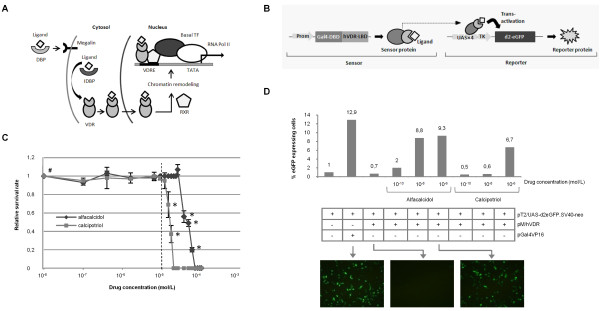Figure 1.

A genetic sensor system for detection of vitamin D analogues. (A) Mechanism of transcriptional activation mediated by vitamin D3. DBP, vitamin D binding protein; IDBP, intracellular vitamin D binding proteins (IDBPs); VDR, vitamin D receptor (VDR); RXR, retinoid X receptor; VDRE, vitamin D response element. (B) Schematic representation of the components of the sensor and mode of action. Promoters are presented as light grey arrows. (C) Effect of calcipotriol and alfacalcidol on cell survival at different concentrations. HaCaT cells were supplemented drug at various concentrations, demonstrating reduced in vitro survival at concentrations ≥10-5 M. Surviving colonies were stained and counted after 8 days. The data are shown as mean values ± standard deviations. A square (#) indicates the level of survival of untreated cells, whereas stars (*) indicate evident change in morphology. The broken line indicates the maximum concentration employed in subsequent experiments. (D) Receptor and sensor function under transient transfection conditions. HEK293 cells were co-transfected with 1.5 μg pT2/UAS-d2eGFP.SV40-neo together with 0.5 μg pGal4VP16 or pMhVDR. The cells were left untreated or exposed to DMSO-dissolved alfacalcidol or calcipotriol at different concentrations (as indicated below the x-axis) 24 hours after transfection. After an additional 48 hours the cells were analyzed by flow cytometry. Expression of d2eGFP in untreated cells was set to 1 (left column). Representative fluorescence microscopy pictures (at 16X magnification; 48 hours after drug supplementation) of relevant combinations of transfected plasmids and drug treatment (as indicated in the table) are shown at the bottom.
